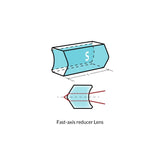-
The emitting facet of the single-mode laser diode is typically 1-micron high and 3-5 microns wide. Its output beam is highly divergent in a so-called "fast-axis" direction perpendicular to the emitter and less so along the facet or "slow-axis". The collimation of such an asymmetrically divergent beam with a combination of the fast- and slow-axis collimating lenses, or FAC and SAC lenses, yields a rectangular beam cross-section not convenient for all applications.
Alternatively, the Fast-Axis Reducer (FAR) lens collimates the fast-axis of a laser diode beam with its convex acylindrical surface. Then, its concave cylindrical surface re-introduces the fast axis beam divergence equal to that of the slow axis. The appropriate lens thickness takes care of beam astigmatism. Pairing the Fast Axis Reducer with a rotationally symmetric lens produces a collimated and round beam.

-
Dimension Tolerance +/- 0.02 mm
Length Tolerance +/- 0.05 mm AR Coating Specification R < 0.5%, AOI 0-30° -
 Fast Axis Reducer lens
Fast Axis Reducer lens
- choosing a selection results in a full page refresh




